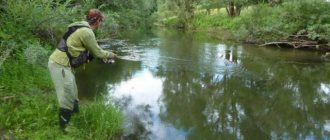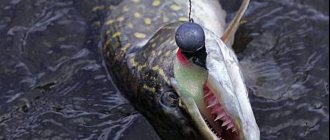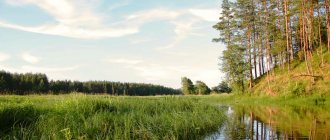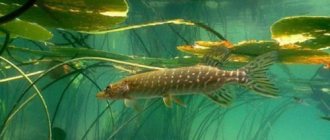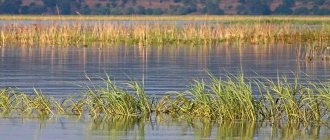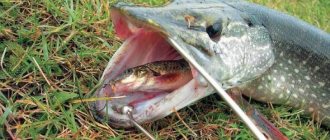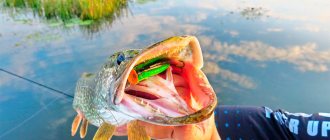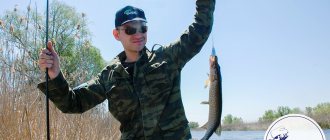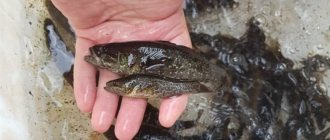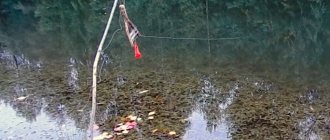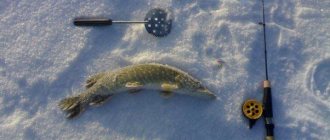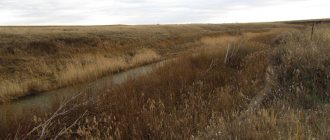Fishing for pike on small rivers is a fascinating and rewarding activity. Fishing in such places is not easy. Fishing has its own specifics and peculiarities. Each body of water is individual, has its own “character” and it is not always possible to find the key to it. Especially when it comes to hunting for a toothy beast. Despite the well-known greed of pike, catching it on a small river is not an easy task. In the process of fishing, the fisherman must solve several problems: detect the ambush of a predator and present her with an appetizing bait, forcing her to bite. On small rivers, mostly small and medium-sized pike are caught. Trophy individuals inhabit such reservoirs, but it is very problematic to provoke them into grabbing. The seasoned predator is a wise fish, leading a measured and careful lifestyle. Therefore, the capture of weighty specimens is extremely rare.
Seasonal fishing features
Each period of the year makes its own adjustments to the behavior of the toothy predator, which must be taken into account by the angler when going fishing on a small river. At certain times, the pike shows maximum activity, greedily attacking any bait that is in its field of vision. Sometimes she completely closes her mouth, not reacting to the most ornate wiring. At the beginning of spring, pike go to spawn. In the middle zone, the process of prolongation of the genus of this predatory fish occurs at the end of March. If the ice melts early, then sometimes it is possible to hunt the toothy beast until it spawns. With the right approach, the result is impressive. Large pike are often caught. You should look for it in deep areas: • in channel ditches and holes; • on slopes and deep edges; • in whirlpools and return streams; • in the area where tributaries and branches flow into the main channel of the river. The predator spawns in shallow water areas. These can be water meadows, channels and branches, backwaters and oxbow lakes, flowing micro-rivers and streams. During this period, the pike does not feed. In addition, in many reservoirs there is a spring-summer ban on catching aquatic biological resources. Stable pike fishing in spring on small rivers after spawning begins in May. The water warms up enough, small fish become active, and the pike begins to feed. During this period, the toothy predator does not immediately leave the spawning grounds. She lingers here and hunts for peaceful fish, which head to shallow waters later.
By the beginning of summer, when the river gradually returns to its banks, the pike disperses throughout the reservoir and switches to the summer feeding mode. Now the predator is located in the upper horizons and water column. Typical places where the probability of its bite is maximum are: 1. Along coastal algae. The toothy one loves to stand among the egg capsules or strips of reeds and sedges. 2. Near the confluence of small streams, rivulets, branches and branches. Here the pike is located on the dumps, waiting for a gaping fish. 3. Single flooded snags, tree trunks and branches. The predator likes to stand in front of an obstacle and is less likely to be behind it. In areas with a measured current, moderate depths and bottom vegetation, pike occupies the bottom layer. She stands at an angle with her head up and is ready at any moment to lunge at her unsuspecting prey. During the hot period, a large number of pike enter various oxbow lakes, inlets and other branches from the main channel. Shallow depths and an abundance of algae attract small roach, rudd, perch and other underwater inhabitants. There is a rich food supply here and there is always something to eat. This concentration of easily accessible prey attracts the toothy beast to these places. This should definitely be taken into account when searching for predators on the river. Advice! When fishing oxbow lakes and backwaters, special attention should be paid to the coastal zone and local islands of algae located on hills in the middle of the water area. In summer, pike on small rivers are most active at dawn. While it is relatively cool, it quickly attacks the offered bait. During the day, the predator rests and digests the prey it has eaten. In cloudy weather or in the presence of medium or strong wind, the bite of the toothy beast can be observed at noon. Autumn is the golden and most productive time for pike fishing on small rivers. In September, the predator stands mainly in shallow areas in the water column. She still eats in summer mode. The difference is that the toothy bite extends during daylight hours. This behavior lasts until the end of Indian summer. In mid-latitudes this occurs at the beginning of October. In mid-autumn, algae gradually begin to die and sink to the bottom. The absence of such shelters and the steadily cooling water force peaceful fish to move to deeper areas, sliding down to their upcoming wintering grounds. Naturally, the pike leaves the shallow water for its food. Now you should look for it in the following locations: • deep holes and ditches; • channel dumps; • medium depths with uneven relief; • single snags and trunks, flooded in deep areas; • returns and whirlpools. In late autumn, pike cannot be found in shallow waters. It can come here only during unexpected warmings. And such behavior is an exception to the rule, so such places should be the last thing to fish. You can hunt for pike on the small river until late autumn. She stops taking only just before the freeze-up. In some reservoirs with ice-free areas, fishing with summer gear, in particular spinning, can continue throughout the winter.
How to catch pike on small rivers
Today we offer the topic: “how to catch pike on small rivers” from professional fishermen. We tried to cover the topic as fully as possible. You can ask all questions in the comments after the article.
Catching large pike on small rivers
Every year it becomes more and more difficult to find large pike and catch large pike on small rivers . This is due to poaching and a huge number of amateur fishermen. But the interesting thing about searching for pike in small rivers is that there is very little of it there. The fisherman will have to make significant efforts to find and catch this predator.
In a small river, the pike keeps a certain area of the reservoir under control, preventing competitors from entering there. There are few reasons that can force a pike to leave its occupied place. For example, this can happen if food runs out in this area or the water level drops significantly.
You won’t be able to catch more than one trophy pike in one place. But this rule does not work when fishing in a deep river bed. In such a place there can be several trophy specimens at the same time.
First of all, when fishing for large pike on small rivers, it is necessary to fish places with strong differences in depth. You need to look for pike at the exit of channel holes; such places can be seen visually.
In shallow water it is almost impossible to find pike. But if there is a channel ditch near a shallow bay, then sometimes you can find pike there too. Pike also love rapids.
You can meet a trophy predator throughout the year, but in the fall, when the water temperature begins to drop, the chance of encountering increases. The most favorable time for fishing comes at the end of September and lasts until the first ice. Before the onset of winter, the activity of large specimens noticeably increases.
You can increase your chance of catching a trophy by going fishing after several rainy days in a row. Weather has a significant impact on fish behavior, and pike are no exception.
In warm weather, predatory fish, which is also true when catching large pike on small rivers, go hunting either early in the morning or after sunset. Pike hunting does not last long, no more than 30 minutes. But after a significant drop in air temperature, pike become active during the day, when the sun sufficiently warms the water. And in the evening he goes hunting both at sunset and after sunset.
On the river it is best to use jig baits. They perform well when catching large fish, which need to be looked for at the bottom.
Most fishermen are mistaken in believing that with a large bait the chance of finding a trophy increases. According to statistics, the best catch comes from medium-sized baits. When using large and small baits, you usually catch small pike, the weight of which does not exceed 3 kilograms.
Features of catching large pike on small rivers video:
Pike on small rivers. Igor Koskov... Wiring technique when catching large pike on small rivers. "Our Fishing"
Fishing for pike on small rivers is a fascinating and rewarding activity. Fishing in such places is not easy. Fishing has its own specifics and peculiarities. Each body of water is individual, has its own “character” and it is not always possible to find the key to it. Especially when it comes to hunting for a toothy beast.
Despite the well-known greed of pike, catching it on a small river is not an easy task. In the process of fishing, the fisherman must solve several problems: detect the ambush of a predator and present her with an appetizing bait, forcing her to bite.
On small rivers, mostly small and medium-sized pike are caught. Trophy individuals inhabit such reservoirs, but it is very problematic to provoke them into grabbing. The seasoned predator is a wise fish, leading a measured and careful lifestyle. Therefore, the capture of weighty specimens is extremely rare.
Each period of the year makes its own adjustments to the behavior of the toothy predator, which must be taken into account by the angler when going fishing on a small river. At certain times, the pike shows maximum activity, greedily attacking any bait that is in its field of vision. Sometimes she completely closes her mouth, not reacting to the most ornate wiring.
At the beginning of spring, pike go to spawn. In the middle zone, the process of prolongation of the genus of this predatory fish occurs at the end of March. If the ice melts early, then sometimes it is possible to hunt the toothy beast until it spawns. With the right approach, the result is impressive. Large pike are often caught. You should look for it in deep areas:
- on channel ditches and pits;
- on slopes and deep edges;
- in whirlpools and return streams;
- in the area where tributaries and branches flow into the main channel of the river.
The predator spawns in shallow water areas. These can be water meadows, channels and branches, backwaters and oxbow lakes, flowing micro-rivers and streams. During this period, the pike does not feed. In addition, in many reservoirs there is a spring-summer ban on catching aquatic biological resources.
Stable pike fishing in spring on small rivers after spawning begins in May. The water warms up enough, small fish become active, and the pike begins to feed. During this period, the toothy predator does not immediately leave the spawning grounds. She lingers here and hunts for peaceful fish, which head to shallow waters later.
Photo 1. The area at the bend of the river.
By the beginning of summer, when the river gradually returns to its banks, the pike disperses throughout the reservoir and switches to the summer feeding mode. Now the predator is located in the upper horizons and water column. Typical places where the probability of its bite is maximum are:
- Along the coastal algae. The toothy one loves to stand among the egg capsules or strips of reeds and sedges.
- Near the confluence of small streams, rivulets, branches and branches. Here the pike is located on the dumps, waiting for unwary fish.
- Single flooded snags, tree trunks and branches. The predator likes to stand in front of an obstacle and is less likely to be behind it.
In areas with a measured current, moderate depths and bottom vegetation, pike occupies the bottom layer. She stands at an angle with her head up and is ready at any moment to lunge at her unsuspecting prey.
During the hot period, a large number of pike enter various oxbow lakes, inlets and other branches from the main channel. Shallow depths and an abundance of algae attract small roach, rudd, perch and other underwater inhabitants. There is a rich food supply here and there is always something to eat. This concentration of easily accessible prey attracts the toothy beast to these places. This should definitely be taken into account when searching for predators on the river.
In summer, pike on small rivers are most active at dawn. While it is relatively cool, it quickly attacks the offered bait. During the day, the predator rests and digests the prey it has eaten. In cloudy weather or in the presence of medium or strong wind, the bite of the toothy beast can be observed at noon.
Autumn is the golden and most productive time for pike fishing on small rivers. In September, the predator stands mainly in shallow areas in the water column. She still eats in summer mode. The difference is that the toothy bite extends during daylight hours. This behavior lasts until the end of Indian summer. In mid-latitudes this occurs at the beginning of October.
In mid-autumn, algae gradually begin to die and sink to the bottom. The absence of such shelters and the steadily cooling water force peaceful fish to move to deeper areas, sliding down to their upcoming wintering grounds. Naturally, the pike leaves the shallow water for its food. Now you should look for it in the following locations:
- deep holes and ditches;
- channel dumps;
- medium depths with uneven relief;
- single snags and trunks, flooded in deep areas;
- return lines and whirlpools.
In late autumn, pike cannot be found in shallow waters. It can come here only during unexpected warmings. And such behavior is an exception to the rule, so such places should be the last thing to fish.
You can hunt for pike on the small river until late autumn. She stops taking only just before the freeze-up. In some reservoirs with ice-free areas, fishing with summer gear, in particular spinning, can continue throughout the winter.
Photo 2. On a small river and after the first snow it bites on a spinning rod.
Fishing for pike with a spinning rod on small rivers is the most common and widespread activity. In addition, catching a toothy predator with artificial bait is extremely interesting, not boring and rewarding. This direction of fishing in relation to reservoirs of the type under consideration has a number of distinctive features that affect the layout of gear and the selection of suitable baits.
Spinning fishing
Fishing for pike with a spinning rod on small rivers is the most common and widespread activity. In addition, catching a toothy predator with artificial bait is extremely interesting, not boring and rewarding. This direction of fishing in relation to reservoirs of the type under consideration has a number of distinctive features that affect the layout of gear and the selection of suitable baits. Beginning fishermen should initially acquire a universal kit that is suitable for most lures and various fishing techniques: • A rod about 2.10 meters long, weight up to 20 grams, medium-fast action. • Reel size 2000–3000, inertia-free, universal with a reduction of about 5.0:1, with good line laying and easy running. • Braided cord and monofilament line with breaking load up to 4–6 kg. It is optimal to get a reel with several spare spools. One must be wound with monofilament. It is useful when fishing with rotating spoons. This type of lure spins the line a lot. This leads to rapid damage and tangling of the cord. Therefore, it is better to use inexpensive and less prone to torsion nylon. Pike baits for small rivers do not differ from those used in other types of reservoirs. Depending on the time of year, the preferences of the predator change, which must be taken into account when selecting the optimal set of catching spoons and wobblers. In spring and autumn, the first place is occupied by various silicone baits. They are the most effective because they allow you to carefully fish promising points and shelters. The best results are shown by banal vibrotails and twisters, which can be equipped either with a hinge or on classic jig heads. With warming, other types of baits begin to work more confidently. The main ones are: • turntables; • minnow wobblers; • poppers.
These baits turn out to be the most versatile and work all summer, showing consistent results. It is also worth paying attention to crankbaits, non-snagging spoons, walkers and spinnerbaits. For small rivers, it is advisable to choose an average size within 7–10 cm.
Fishing in autumn
In September, pike again visit shallow waters and can be caught here all day long. But it’s better to start looking for it in the morning or in the evening. Well, don’t forget about fishing on cloudy days or when it’s raining. But mostly during the long day she still rests.
At the end of September, beginning of October, the pike zhor begins. She becomes crazy and can easily ruin the hunter’s property, so you need to take care of strong gear. But you can fish however you like: with a spinning rod, a fishing rod, live bait or any other bait. It’s also worth trying new fishing techniques. It is also important to know where to look for pike in a small river. It leaves the shallow water and takes up its favorite places: holes, snags, littered trees, backwaters, the mouth of a river or the confluence of streams. She may swim into shallow water, but this will be the exception rather than the rule. A plus for successful fishing is that most of the algae dies off.
In November, the predator begins to worry about the upcoming winter and therefore tries to find a secluded place. Small rivers must be fished first, because then they can become covered with ice. Fishing in the coastal zone, in shallow water, for small pike can only be done if warming is expected.
In autumn, the best time for fishing is the middle of the season.
In clear weather it is better to fish from early morning, in cloudy weather - at least all day. And also don’t forget about atmospheric pressure.
Fishing with live bait
Fishing with live bait brings good results. There are several main options to achieve stable catches in open water: • mugs; • donka; • summer girders; • running donka. With a thoughtful approach and some experience, the listed areas can compete with spinning in terms of effectiveness. In the cold season, pike fishing is practiced with girders on small rivers. The best live baits for pike hunting are crucian carp, rudd, roach and silver bream. These are the most delicious objects for a predator. Perch, ruffe, gudgeon, and goby are also suitable. In the absence of the listed types of fish, you can even use bleak or high water, the disadvantage of which is their minimal survivability.
Bait
Next, you need to understand what you can use to catch the desired pike, what baits will be successful on small rivers. Here they are used according to your taste and wallet. But sometimes it’s better to select them depending on the state of the river and weather conditions. It is recommended to stock up on silicone baits for fishing in spring or autumn. Jig baits will be good when exploring places with grass, near algae, and reeds. Wobblers and poppers will help the fisherman in the warm season. Classic lures will perform best all the time; it is better to take them in a medium size.
If the river is opaque at the time of fishing or the weather is very cloudy, then you should use bright, flashy baits. With clear light, on the contrary, you need either matte or modest nozzles.
It is worth choosing bait taking into account seasonality
Read expert opinions
About the features of fishing described in the article
pike
About the features of the types of fishing described in the article
spinning
live bait fishing
Useful tips
Pike fishing is carried out using different methods and using a variety of baits, but not everyone can achieve success. Some subtleties that more experienced fishermen share with us will help you win a trophy:
- pike fishing on small rivers will be successful before and after dams;
- when fishing rivers, an important indicator will be the location of the bait; it should be pressed as close as possible to the bottom;
- fishing from the shore involves casting bait and retrieving it perpendicular to the riverbed;
- when twitching, pay attention to the length of the pauses; the warmer the water, the shorter they are;
- on large rivers the bait is taken with the flow; pike will not attack against the water flow in order to save energy costs;
- fishing with poppers is carried out only in the summer in cloudy weather, the bait is placed along the coastline;
- small schools of fry will be a sure sign of the presence of a pike nearby; you should throw the bait next to them and move it slowly.
Many people prefer to catch pike on the river, although it is more difficult than in lakes. But if the fisherman is lucky, he will definitely find a trophy specimen of a toothy predator.
Pike of small reservoirs
This voracious, cunning, but cautious predator can be caught at any time of the year. But unsuccessful pike fishing in the summer leads to the fact that some fishermen completely forget about it in the fall. But in vain they do this. You can also hunt for pike in the fall, and it’s not bad at all. You just need to know where exactly to do it and avoid the mistakes that some people often make.
In late autumn, as usual, inclement weather sets in. Catching pike from the lady's boat becomes impossible. It is also impossible to catch it from the shores of large bodies of water; you simply cannot get it. The water becomes colder at this time. For this reason, floating green plants die off, larger representatives of aquatic flora will dry out and the water will become more transparent. In such reservoirs, in shallow water, in water saturated with oxygen, the predator loves to be at this time.
This is especially typical for reservoirs where a sufficient number of different species of fish live. It is in such shallow, small-sized bodies of water that this predator should be hunted in late autumn.
However, many believe that only bee-eaters are found in such small bodies of water, and there have never been any traces of large specimens here. This is an absolute statement that does not deserve any discussion.
Signs of the presence of large individuals
Based on a number of characteristic features, we can conclude that it is here that there is an opportunity to get a large trophy.
- 1. The reservoir is very rich in natural live food for pike. There are many perches and other fish species.
- 2. The average weight of caught specimens of squints approaches five hundred grams.
- 3. In winter, this body of water almost never freezes completely to the bottom.
- 4.Test marks from the teeth of caught squint or other fish, more than ten centimeters.
- 5. The presence of schools of perches of different numbers, very active in their behavior.
Small active perches always attract pike, because it is the perch that is the predator’s favorite treat. Pike are certainly not as active in feeding as perch. She has long intervals between meals. She needs to digest large prey, and this takes time. But when she gets hungry, she goes hunting. In response to this, the perches seem to become quiet and the bites stop. This is a signal to the fisherman that there is a pike somewhere nearby.
Also interesting: Pike fishing on the first ice
Practice shows that quite often decent specimens of Her Majesty’s pike are caught in small rather than large reservoirs. This is understandable, because logically the probability that bait on a small lake will be found in its immediate vicinity is much higher than, say, on a huge reservoir. The bait is in one place, and the pike is a kilometer away from it. Catching this predatory representative in small reservoirs has its own nuances.
At the same time, fishermen often make the same typical mistakes
- 1. The size of the bait is too small. Considering that there are no large specimens here, the fisherman also uses a small-sized spoon. The golden rule says that the ideal bait is one that is commensurate with the fish that the pike feeds on, and for a predator this is neither more nor less, but ten percent of the mass.
- 2. Having made unsuccessful attempts to catch pike in hot weather in the summer, many anglers generally put spinning on the back burner. All this, of course, is in vain. After all, it is on small bodies of water in the fall that she feels freedom, harmoniously combined with her predatory nature. Hunting for predators here is not only possible, but also necessary.
- 3.Frequent use of artificial bait. In small bodies of water, the predator is deprived of the opportunity to frequently swallow live bait. But she needs to grow. We must learn to use live fish more often when catching this predator.
- 4. Sometimes the fisherman simply does not have enough endurance and patience. The specificity of small-sized reservoirs suggests that for a short time, they, as they say, pass along and across it. There is no bite, no trophy and the fisherman simply leaves, concluding that fishing here is useless. But this is done in vain. You have to stay and continue fishing and luck will certainly smile.
The fisherman left, and the cunning pike sits in the water and laughs at him. Practical experience in catching this predator shows that, despite the fact that there was not even a single bite during the day, it is highly likely that it will bite in the evening. We should not forget that pike do not feed every hour, or even every day.
Also interesting: Catching pike with live bait in snags in winter
Having made a throw once and caught a large prey, it will digest it for a long time. But when she gets hungry again, the chances of catching her will increase enormously. Then the next time you come to a pond, even if it seems too shallow, small and unsuitable for pike to live in, you must make every effort to prove the opposite.
You can look for one or another body of water for the upcoming autumn fishing for large predators by simply asking the fishermen living here who prefer fishing with a regular float rod. It is worth asking them in detail which fish are mainly found in it. Has it become less over the last, say, year, or, on the contrary, has its quantity increased?
If the roach or sleeper has become larger, but their number has decreased, this means that the pond has been populated by pike and perch. In addition, you need to ask if the caught specimens have any characteristic marks. If the number of such fish has increased, i.e. Since they are actively breeding, it is useless to catch pike here, it is simply not here. Of course, rare individuals may appear with the introduction of waterfowl eggs, but the cramped conditions of a small reservoir do not allow them to reproduce properly.
An amazing feature of this far from stupid predator is that it has an excellent art of camouflage. Provided the water is fairly transparent, it is not always possible to see it. But this does not mean that the pike cannot be visually detected at all.
During the spawning period, the predator, in the heat of the excitement of love games, often splashes out of the water. Thus, you can clearly see what kind of trophy you will eventually catch, which will be a specific reason for the fisherman’s pride.
